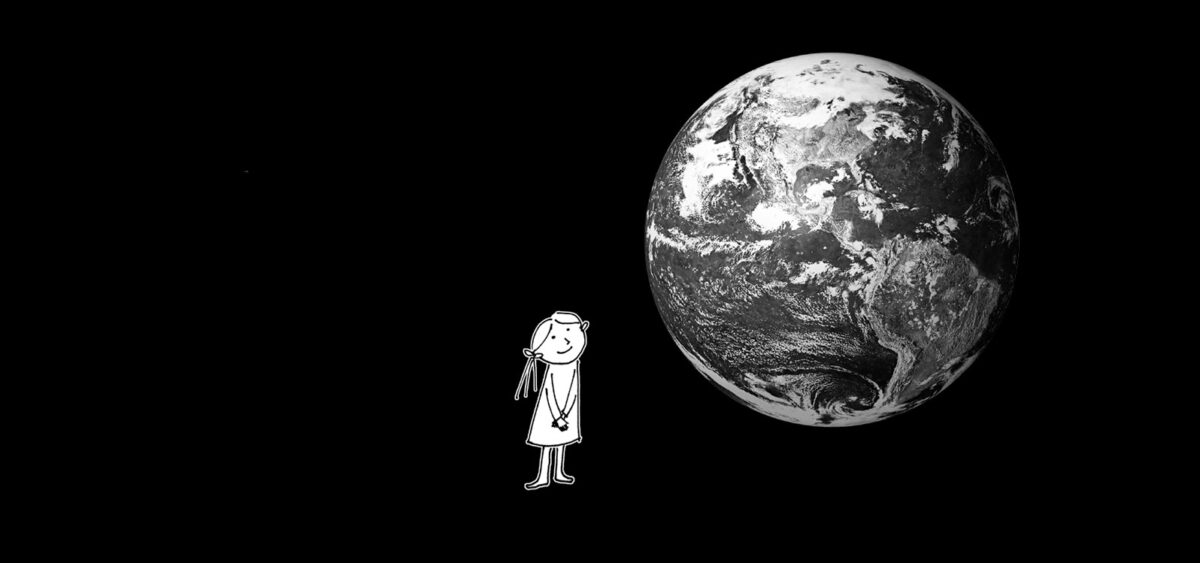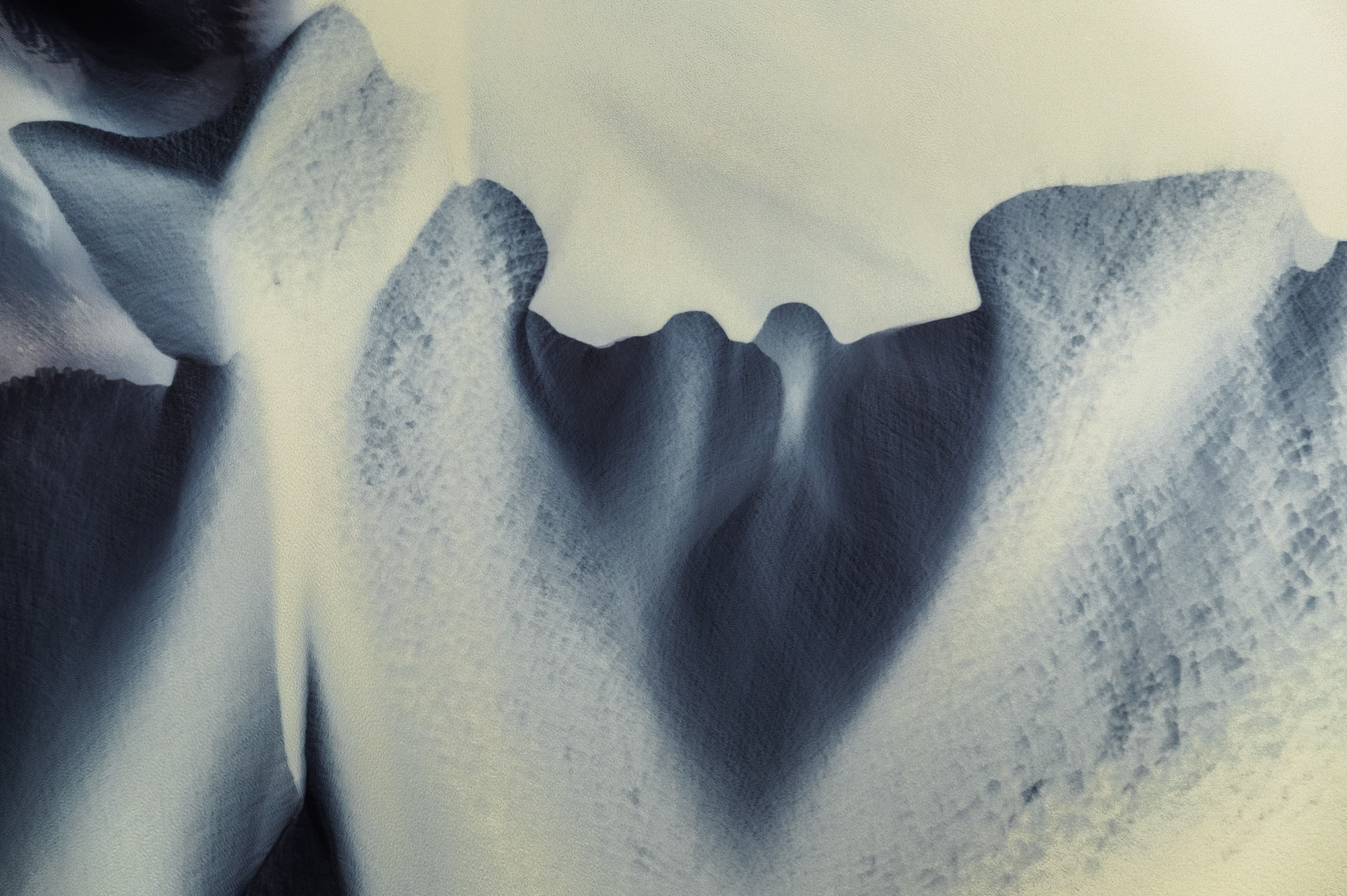
Sometimes we talk about her with affection, like the poet Edward Stachura, who sang that she is “carrying, carrying her lovely hunch.” Sometimes, we use more pathos, which seems more appropriate, and call her Mother Earth.
We first saw the Earth in the famous photo Earthrise taken in December 1968 by William Anders, who participated in the Apollo 8 flight. Although it wasn’t the first ever photograph of our planet, it was the first colour one, which made it possible for us to notice how its vivid colours contrast with the grey and lifeless surface of the moon. In this picture, the Earth looks beautiful and fragile. I saw with my own eyes how huge it is during my first voyage to Antarctica.
Cycling to Antarctica
The journey from Gdynia to the freezing end of the world (not literally, since the sphere has no end) lasted 40 days. Our ship was sailing at a speed of 12 knots, which is 12 nautical miles per hour. The nautical mile is a unit of measurement used in marine and air navigation. It is equal to the length of one minute of arc along any great circle (e.g. the equator or a meridian) of the Earth – i.e. 1852 metres. In other words, we were sailing to Antarctica at a speed of about 20 kilometres per hour, which is as if we were cycling.
During that journey, I also saw for myself that the Earth is, indeed, round. It was one of those revelations that I call a ‘dumb discovery’ – things we could come up with by ourselves right away, if only we put some thought into them. About halfway through the cruise, we started to notice that the moon seemed a little weird. At first, it was hard to figure out what was going on. Also, for a long time we had been able to see only a small part of it. Once we passed the equator, however, we saw the full moon, and, indeed, it looked different. Then, during an evening party, one of my colleagues stood with his legs slightly apart, turned his rear-end towards our favourite satellite and stared at it through the space between his legs. And, indeed, the moon was now ‘upside down’, which shouldn’t be surprising given the shape of our planet and our location. Yet it’s one thing to imagine it, and another to finally see it with your own eyes.
Flat, empty, or with a nipple
It was already back in the 6th century BCE that Greek philosophers – for instance, Pythagoras – argued that the Earth was round, even though the majority contended that it was flat. At the beginning of the 4th century BCE, Plato explicitly wrote about the spherical Earth. By 330 BCE, Aristotle had proved it experimentally. 100 years later, Eratosthenes of Cyrene calculated the Earth’s circumference with a relatively high degree of accuracy. Relying solely on the gnomon (a simple stick), he measured the angle of the sun’s rays in Alexandria and Syene (today’s Aswan) and based on the distance between the two cities, he calculated the curvature of the Earth. Then he estimated the planet’s circumference to be equal to 250,000 stadia. Unfortunately, we don’t know the exact modern conversion, but one stadium is somewhere between 155 and 160 metres. This makes his estimate only about 1% too small.
From that point onwards, the great majority of scholars expressed their conviction that the Earth was round. It isn’t true that in the Middle Ages people thought otherwise – at least not the educated ones. As Umberto Eco writes in his Book of Legendary Lands, even Dante recounted how after descending into hell, he came out on the other side and saw stars he’d never seen before. The myth that Christians believed the Earth was flat was created and spread mainly through Washington Irving’s 1828 biography of Christopher Columbus. Irving depicted this greedy, cruel and rather lousy sailor from Genoa as an enlightened daredevil who courageously sailed west to prove to the European elites that the Earth was round. Although this was only Irving’s fantasy, he managed to kill two birds with one stone: he whitewashed the Columbus story and denigrated mediaeval science. Although Christian philosophy between the 4th and 6th century (1000 years before Columbus) included some descriptions of the Earth as flat and the universe as a tabernacle, later thinkers, such as St. Thomas Aquinas, considered our planet to be spherical. This knowledge was officially passed on at mediaeval universities (including the one in Kraków where Copernicus studied astronomy).
What really strikes me, however, is that even today some people believe that the Earth is flat. At first I thought it was an ironic joke – like the Church of the Flying Spaghetti Monster – but some flat earth societies actually have a lot of members (and can be found all over the globe, which is one of the funniest parts of this unbelievable story). For obvious reasons, past attempts to revive flat earth theory fell through rather quickly, especially after the age of great geographical discoveries. The theory that is popular today was conceived by Wilbur Glenn Voliva, the head of the Christian Catholic Apostolic Church in Zion, Illinois. He promoted his ideas between 1906 and 1942. In his Book of Legendary Lands, Eco describes some of Voliva’s actions, writing of how when it was pointed out to Voliva that if his ideas had been correct, the circumference of the Antarctic circle would have been 68,000 kilometres, whereas the number provided by those who circumnavigated the Antarctica was considerably smaller, he would just casually change the subject.
One of the weirdest chats I have ever had took place on a flight to Spitsbergen. When I was boarding the plane in Oslo, I was spotted by one of the flight attendants. Since I was on my way to work, I was wearing an Arctowski Station jacket with a patch reading ‘Polish Antarctic Expedition’. The flight attendant got excited about Antarctica and asked me if I had been there before. When I said yes, he checked my seat number and told me he wanted to chat. About an hour later, he approached me with an extra bottle of wine (the airline I was flying with offered only one for free) and invited me to join him in the crew section of the plane. He asked right away if I was sure that it was Antarctica that I had visited, and seemed a little confused when I told him I sailed there across the entire globe three times, and lived in the Polish Antarctic Station for nearly three years. I also told him that since 2002 I had been regularly visiting this region. He was very nice and eloquent, but for half an hour was trying to convince me that a flat disc would look the same and that we weren’t able to see Paris at the moment only because of the overcast sky and pollution. And the man saying all these things was the same man who regularly saw the curve of the Earth from a plane.
Flat earth theory is simply not smart – and rather boring. I regard as more attractive the hollow earth theories, which have been part of both literary fiction and scientific literature (including aesthetically appealing science publications) for hundreds of years. It wasn’t completely hollow from the start. In his book Telluris Theoria Sacra (1681), Thomas Burnet argued that the planet was full of water, which spilled during Noah’s Flood and then fell back inside. A different depiction was provided by Athanasius Kircher, the author of the first scientific world map, which depicted sea currents and interlaced underground volcanos. In his book Mundus Subterraneus (1665), he mentioned rivers of underground lava (he was actually right about this), inhabited, for instance, by dragons (sadly, he wasn’t right about this).
In 1692, Edmond Halley – the one with the comet – considered the Earth to contain populated and lit continents. He argued that although it wasn’t possible to reach it, our world was connected with an internal one through the Earth’s poles. He believed that the gases released from those connection points formed what we know as polar lights. Ever since I read his theory, I haven’t been able to resist imagining colourful gases coming out of narrow holes in the poles. Actually, as it can’t be verified, it might be assumed that those internal continents are inhabited by rainbow unicorns, who cause this colour splash.
In the 18th and 19th century, various novelists such as Jules Verne, Ludvig Holberg and even Giacomo Casanova gave similar depictions, placing in the underworlds more advanced civilizations, egalitarian societies, wise men from Egypt, or other monsters. According to Eco, one of Holberg’s works worth paying special attention to is Nicolai Klimii iter subterraneum (1741). Curiously enough, Adolf Hitler also supported the hollow earth theory, but – as we know – he believed all kinds of absurd theories, including the one about the existence of various human races and that some of us are better than others.
A different perspective was offered by another criminal: Christopher Columbus, who is mainly known for miscalculating the Earth’s circumference. He got lost while sailing across the Atlantic and, convinced that he had reached India, was found on the coast of North America by the Indigenous peoples, most of whom he later exterminated as a gesture of gratitude. Columbus thought that the Earth was shaped as a pear, or “as if one had a round ball and, on one side, it should be like a woman’s breast and this nipple part is the highest and closest to Heaven.” Supposedly, this nipple was located somewhere near Latin America, which explained why it was so hot there – because of its vicinity to the sun. I don’t recognize any other achievements of Columbus, because one simply can’t ‘discover’ a continent that had already been inhabited by millions of people for over a dozen thousand years, and which had already been visited by other Europeans – the Norse – 500 years earlier.
We’re not the hub of the universe
When I look at the various theories, including the factual one, my favourite is Terry Pratchett’s idea of the Discworld resting on the backs of four huge elephants, which, in turn, stand on the back of the giant turtle A’Tuin, which swims through space. I’m aware, however, that in all likelihood the only true part of this story is that the Earth keeps moving. It is precisely because of how significant this discovery is that I consider Copernicus – next to Darwin and Lynn Margulis – to be the most important historical figure, who showed us who we really are and what our place is in the universe. Obviously, the theories of heliocentrism and natural selection reached many more people than Margulis’s endosymbiotic theory, but they are all equally important in terms of their philosophical value. Thanks to Copernicus, we know that we’re not the hub of the universe, around which everything else revolves, but one of many planets that orbit the sun. Darwin proved that we are intertwined with other elements of the organic world – rather than the highest form of creation, we’re part of a gigantic family that includes other, equally important creatures. Margulis, on the other hand, showed us that we need to redefine who we really are, because each cell in our body comprises essential-for-life organelles and DNA fragments, which used to be bacteria and viruses, but now co-create what we consider ourselves. We might not know what the ‘self’ exactly is, but we know for sure that it’s not a singular being, since we are intimately entangled with the rest of the universe and animate nature.
Red Crow and science
Since the 18th century, scientists have been increasingly attuned to how all the Earth’s systems are integrated. The first to ponder these connections was James Hutton, followed by Alexander von Humboldt in the 19th century. Then, in the 20th century, a few Russian and Ukrainian scientists, including Vladimir Vernadsky, explicitly discussed the entanglements and regulatory systems of our planet, but the so-called West couldn’t see their works. All these observations were brought together and expanded by James Lovelock, who in 1972 proposed a theory that he later termed the Gaia hypothesis (also known as the Gaia principle). Soon afterwards, his theory became supported by Lynn Margulis, whom I have already mentioned. Gaia is not only the middle name of my daughter, but also, of course, the Greek goddess of the Earth. The principle put forward by these scientists is particularly close to me, although even its proponents agree that it’s more like an effective metaphor than a real scientific hypothesis. It conceives of the Earth as one huge organism, which self-regulates its temperature and humidity, while its waters are like a bloodstream. The more we learn about environmental water flows, oceanography, climate and the circulation of matter, the better we see how accurate this analogy actually is.
One might wonder how come that among all the planets, it’s the Earth that provides the perfect conditions for humans and other organisms to survive. Some even argue that it can’t be a coincidence and that someone must have designed it like this. However, as Richard Dawkins once rightly observed, such deliberations are completely pointless. It is precisely because of these specific conditions that the Earth became habitable and we’re now able to reflect on that. There are so many planets in the universe that on one of them such conditions naturally developed. Life didn’t need to search for things that would make it possible: it’s thanks to these things that it evolved.
If, however, Gaia is our perfect home, who are we as humankind? Well, we’re definitely part of this complex network of life, but increasingly often one can’t help feeling that we’re actually more like a parasite, virus or even cancer that is growing uncontrollably. It’s true that we have a right to be here, just like tree frogs, roe deer, the potato beetle and wild garlic. But we clearly misuse this right and, in consequence, Gaia is getting more and more sick.
Our ancestors, like most of the few Indigenous populations that have survived, felt that they were an integral part of their ecosystems and remained aware of their connection with other elements of the planet. One might argue that this was merely a result of the lack of technological capabilities rather than a manifestation of nobleness. There are some recorded examples of a sudden change of behaviour in the face of new possibilities. For instance, the Indigenous peoples of the North American taiga became responsible for a considerable reduction in the caribou population. What happened is that in the second half of the 19th century, they got access to firearms. In accordance with traditional wisdom, they killed as many caribous as they could, only that suddenly they became capable of killing many more. As stated in historical records, dead caribous blocked the flow of rivers. The tribes living in the forest had more than enough food, but the scale of summer migrations to the tundra diminished so much that the tribes living further to the north – the Ihalmiut Inuit – would run out of their traditional food.
Nonetheless, the Inuit and other Indigenous tribes of America understood and emphasized their unity with the environment. Some, like the Hopi, even consider themselves to be Earth Wardens. As one of their tribal leaders, Floyd “Red Crow” Westerman, has more recently stated: “Our DNA is made of the same DNA as the tree. The tree breathes what we exhale. When the tree exhales, we need what the tree exhales. So, we have a common destiny with the tree. We are all from the earth. And when earth, water, and the atmosphere is corrupted, then it will create its own reaction. Mother is reacting.” This is exactly what contemporary science claims.
Get it together right away
David Attenborough once said that someone who believes in constant growth on a planet that isn’t growing must be either a madman or an economist. But we’re still pursuing the idea of constant growth, even though most organisms grow only during the first phase of their life. After reaching maturity, the continued growth leads either to obesity or cancer. Some calculations show that if everyone on Earth wanted to live like an average US citizen, we would need five planets. Europeans prove slightly better: if everyone wanted to lead our lifestyle, we would need only three planets.
Gaia’s main cooling systems are my favourite: the polar regions. They prevent the planet from overheating thanks to such mechanisms as, for example, the albedo effect (a measure of the reflectivity of differently coloured surfaces). White surfaces reflect a lot of radiation, so when there is more ice and snow, less sun rays reach the Earth and their thermal energy is used mainly for melting ice and snow (and not warming other surfaces). When there is less ice, however, the dark ocean waters and black rocks absorb much more energy. It’s getting warmer, more ice is melting, and more dark surfaces are getting exposed. We’ve been fuelling this vicious circle of positive feedbacks by releasing into the atmosphere unprecedented amounts of carbon dioxide.
In 2019, the book This is Not a Drill: An Extinction Rebellion Handbook was published. It’s a collection of short texts written by people who belong to one of the most important movements for environmental justice that has emerged recently. One of the authors, Matthew Todd, calls the ecological breakdown an “express train”, emphasizing that on a destroyed planet there won’t be LGBT rights, feminism or racial justice. In other words, everything for which we are rightly and nobly fighting will lose significance in the face of the environmental degradation of our world. Just like the consequences of COVID-19 fade when discussed in the context of the impending climate catastrophe. But still, as Todd writes: “These are the most appalling of times, made all worse by the fact that most people seem to have no idea of how bad things really are.” In Poland, similar views are being expressed by Szymon Malinowski, the head of the Geophysics Institute at University of Warsaw’s Physics Faculty, a specialist in atmospheric physics, and the protagonist of the climate documentary It’s Okay to Panic. He says – and he really knows what he is talking about – that “the world is moving towards the abyss.” In 2018, Poland became the world leader in carbon dioxide emissions, but the ruling politicians keep on ignoring the problem. At the same time, scientists have estimated that within the next 10 to 12 years, we should reduce emissions by 50%, and by 2050 to 0.
As I have noticed, many people – including myself – who care about environmental protection, and saving the world in general, increasingly often suffer from climate depression: a kind of anxiety that inhibits action. I think this is caused by their increased sensitivity; the same kind of sensitivity that makes them want to save the world in the first place. This is coupled with a bigger awareness of the problem since, understandably, those committed to protecting the environment know more about the climate crisis than others. In consequence, a larger amount of depressing information reaches the more vulnerable ones.
This information, however, can’t be ignored. “People don’t have knowledge, but opinions. They don’t know, but they think they know better,” says Malinowski, referring to people’s reactions to global warming. We already know that the Earth is neither flat nor hollow, but round. We know that life on Earth is a complex and intricate network of relations. We know about the greenhouse effect. There is no room for opinions here. We need to act based on the knowledge we have.
Of course, one might pretend that nothing is going on and live as they used to, without worrying about the future. The Earth itself will survive the climate catastrophe, but many species won’t, including – sooner or later – ourselves. In general, life on Earth will be sustained, but the conditions will change radically. As Malinowski puts it: “We’re going to destroy the basis of our life, and the time will go by. Without us.” Is that what we really want?
I don’t know about you, but I’d like to stay here a bit longer. I’d like to see the Galápagos Islands and Komodo dragons. If this plan doesn’t work out, I hope to enjoy the wild Białowieża Forest. I want to see my daughter growing up happily. All this can happen, but we need to get it together right away. We need to choose systems, technologies and leaders who will make it possible and who care. It’s not too late, but the time to act is now. Let’s give Gaia (both the big and the little one) a chance.










